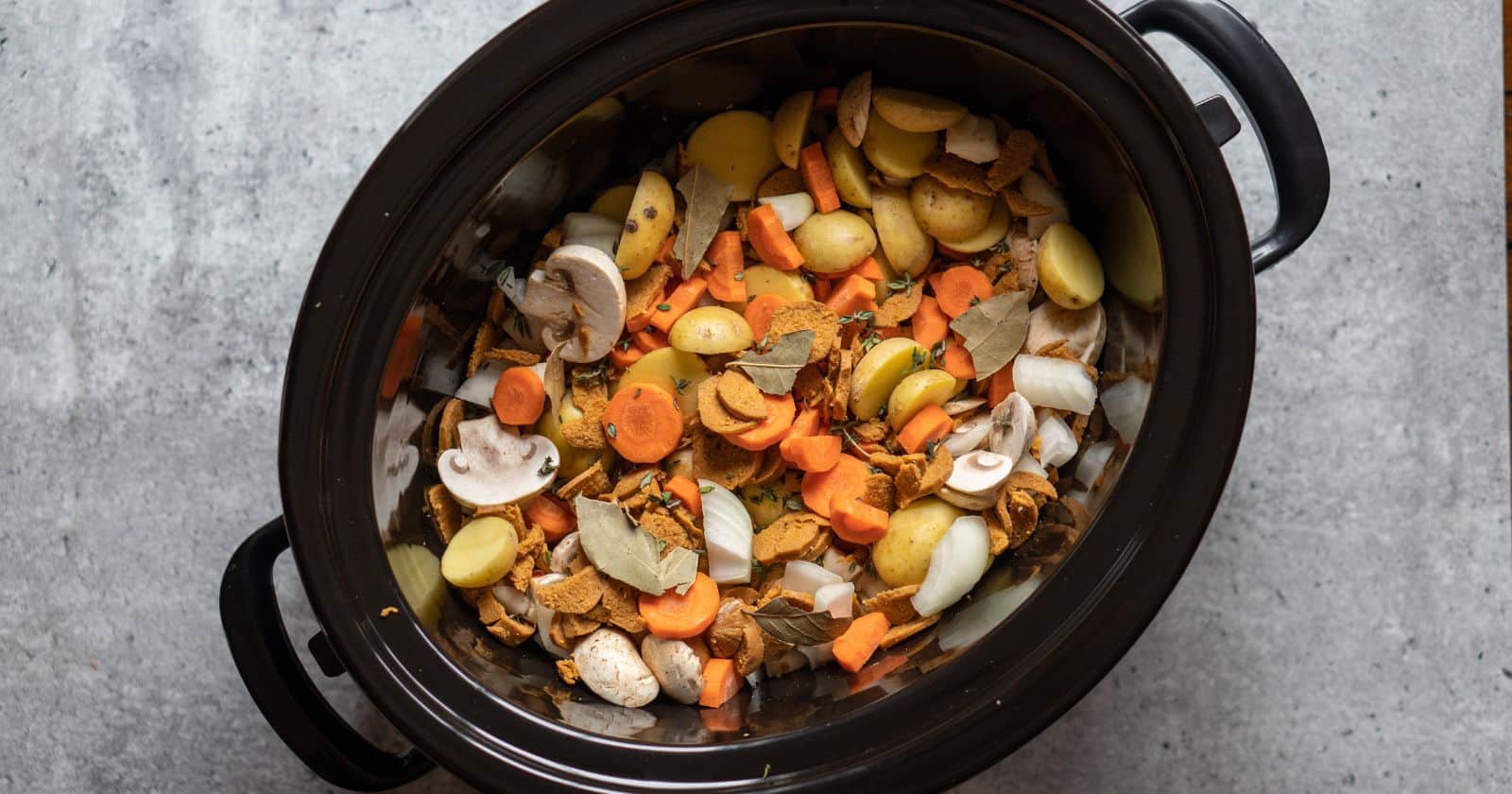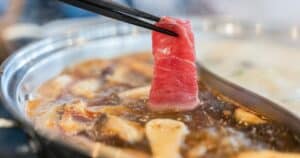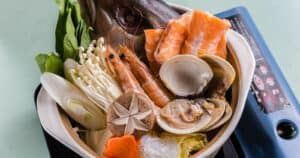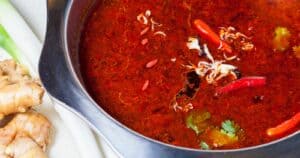You’re craving a warm, comforting meal that’s easy to make at home. Both hot pot and crock pots sound appealing – but what’s the difference between these popular one-pot dishes? With similar sounding names and methods, it’s easy to get them confused.
The main distinction lies in the cooking liquid. Hot pot features a simmering pot of broth at the table that you dip raw ingredients into to cook at the last minute. Crock pots use slow, moist heat over many hours to tenderize tougher cuts of meat and meld flavors.
With hot pot, you dip thinly sliced raw proteins and veggies into the boiling broth to cook tableside. The reward is being able to enjoy extremely fresh, quick-cooked items swirled in flavorful liquids. It brings an interactive element to dinner. Crock pots feature larger, tougher cuts of meat cooked low and slow in a flavor base until fall-apart tender. This hands-off approach allows you to prep in the morning and enjoy a complete meal later.
While both provide comforting one-pot meals, hot pot and crock pots have distinct differences when it comes to ingredients, cooking methods, and interactive elements. Once you understand their unique strengths, it makes choosing between them easier. Keep reading to learn how to distinguish these similarly-named but actually quite different cooking styles.
Cooking Approach
The most obvious difference is the actual cooking method used:
Hot Pot
- Cooks through simmering broth at the table
- Very fast cooking times
- Interactive, dip and swirl cooking style
- Thinly sliced ingredients
- Often enjoyed communally
Crock Pot
- Uses slow, low moist heat over many hours
- Very long cooking times
- Walk away and forget cooking
- Usually larger, tougher cuts of meat
- Makes many portions for leftovers
Hot pot provides fast cooking in simmering broth, while crock pots offer slow and steady moist heat. The preparation, ingredients, and results reflect these opposed approaches.
Ingredients
The ingredients you use in hot pot vs. crock pot also differ significantly:
Hot Pot Ingredients
- Thin sliced proteins like beef, pork, seafood
- Quick-cooking vegetables like mushrooms, spinach, scallions
- Fresh noodles like rice noodles or udon
- Flavorful, seasoned broth
Crock Pot Ingredients
- Tougher, fattier cuts like pork shoulder, chuck roast, beef brisket
- Hardy vegetables like potatoes, carrots, celery
- Dried beans, lentils
- Rich braising sauces and flavor bases
Hot pot requires thinly sliced meats and tender veggies that cook quickly. Crock pots work best with tougher meats, sturdy veggies and legumes that become tender over time.
Flavor Profiles
The resulting flavor profiles also contrast:
Hot Pot Flavors
- Light, clear broths emphasize ingredients’ natural flavors
- Sauces and spices let you adjust flavor
- Extremely fresh taste
- Customizable to taste preferences
Crock Pot Flavors
- Rich, intense, melted flavors from long cooking
- Ingredients marry into cohesive, blended flavors
- Umami, savory flavors
- Consistent flavor profile throughout
The quick cooking of hot pot produces cleaner, fresher flavors that you control with dipping sauces. Crock pots create more blended flavors melded into the cooking liquid.
Ease of Cooking
Prep and cooking also differ greatly:
Hot Pot Ease
- Ingredients require lots of prep and slicing
- Active participation throughout meal
- Quick cooking at the table
- Easy to customize as you go
Crock Pot Ease
- Ingredients can be prepped quickly or not at all
- Walk away set-it-and-forget-it cooking
- Unattended cooking for hours
- Consistent results with less monitoring
Hot pot is very hands-on, requiring thin slicing and active participation. Crock pots require little oversight once the ingredients go in.
Serving Style
These options also have different serving styles:
Hot Pot Serving
- Usually served communally, family-style
- Customize your own bowl
- Interactive, dip and swirl
- Cook ingredients how you like
Crock Pot Serving
- Typically makes large batches or servings
- Serves many people
- Portion out servings from batch
- Consistent pieces and textures
Hot pot encourages communal, interactive cooking and eating. Crock pots provide hearty portions you can dole out from a large batch.
Equipment Needed
The necessary equipment differs too:
Hot Pot Equipment
- Purpose-built hot pot unit or pot
- Individual dipping bowls
- Strainers or slots
- Optional burners at table
Crock Pot Equipment
- The crock pot appliance
- Serving dishes
- Ladles and spoons
- Not much else!
Crock pots need only the appliance itself. Hot pots require accessories like burners, strainers, and individual dipping bowls.
cleanup and leftovers
You’ll be cleaning up after these meals in different ways:
Hot Pot Cleanup
- Multiple pots and dishes to clean
- Clean as you go
- Components cool quickly after cooking
- Leftovers limited to unused items
Crock Pot Cleanup
- Usually just the crock insert and serving dishes
- Larger quantity of leftovers
- Food stays hot for hours in the crock
- Can clean once cooled
With hot pot you’re cleaning multiple items as you cook. Crock pots leave just the insert and dishes with ample leftovers.
Recipes and Variations
The recipes differ vastly as well:
Hot Pot Recipes
- Numerous broth options like miso, Szechuan, tom yum
- Dipping sauces and condiments
- Raw quick-cooking ingredients
- Customize tastes as you cook
Crock Pot Recipes
- Usually based around tough cuts of meat
- Hearty vegetables, beans, lentils
- Flavor bases like tomato sauce, wine, stock
- Seasonings for layers of flavor
There are endless broth flavors and dipping sauces for hot pot. Crock pot recipes focus on turning tough cuts into tender masterpieces.
FAQs About Hot Pot vs. Crock Pots
Still trying to grasp the key differences between these popular one-pot cooking methods? Here are answers to common questions:
Is hot pot or crock pot healthier?
Hot pot can be healthier due to the quick cooking and fresh ingredients. Crock pots use more fatty cuts and sodium from seasonings. But both can be made healthy by modifying ingredients and sauces.
Which option requires more active cooking?
Definitely hot pot – you must actively cook ingredients tableside. Crock pots only need occasional stirring, so it’s more hands-off.
Can you use a crock pot to make hot pot?
Not traditionally, since the broth won’t boil. But you can approximate it by cooking ingredients in the crock pot’s sauce then serving them with hot broth for dipping.
Is hot pot or crock pot better for meal prepping?
Crock pots excel at meal prepping! The large batches are perfect for making several servings at once. Hot pot is best for ready-to-eat meals.
Which type of meal has more variations?
Hot pot wins for versatility! There are endless broth flavors, dipping sauces, meat and veggie options. Crock pot recipes tend to follow similar templates.
When to Choose Each Method
Given the differences, when should you use each technique?
Choose Hot Pot For:
- Quick weeknight meal
- Customizable, interactive cooking
- Cooking and socializing simultaneously
- Showcasing pristine, fresh ingredients
Choose Crock Pot For:
- Weekend or holiday cooking
- Minimal supervision needed
- Making large batches or meal prepping
- Turning less ideal cuts into tender meals
So in summary, hot pot and crock pots take opposite approaches to deliver comforting one-pot meals. Understand their unique strengths to decide which method suits your cooking needs and tastes!





